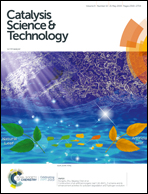N![[double bond, length as m-dash]](https://www.rsc.org/images/entities/char_e001.gif) N bond cleavage of azobenzene via photocatalytic hydrogenation with Dy-doped Zn(O,S): the progress from hydrogen evolution to green chemical conversion†
N bond cleavage of azobenzene via photocatalytic hydrogenation with Dy-doped Zn(O,S): the progress from hydrogen evolution to green chemical conversion†
Abstract
Hydrogen-evolved Dy-doped Zn(O,S) photocatalysts with different amounts of Dy precursor have been synthesized, characterized and further utilized for hydrogenation reactions. The Dy catalysts are first examined using electrochemical impedance spectroscopy, photo responsivity, and the hydrogen evolution reaction. Dy-doped Zn(O,S) with 10% Dy precursor shows the best photocatalyst performance with the highest H2 production rate of 8.160 mmol g−1 h−1. This catalyst is chosen for conducting the hydrogenation reaction. It is our intention to confirm the correlation between the photocatalytic H2 production rate and the hydrogenation reactions of 4-nitrophenol to 4-aminophenol and azobenzene to aniline, which is a step further in the hydrogenation reaction to challenge the N![[double bond, length as m-dash]](https://www.rsc.org/images/entities/char_e001.gif) N bond cleavage of azobenzene. A 100% photo conversion of 60 ppm azobenzene to aniline in 6 h was confirmed under a low-power UV light illumination in a 10% ethanol solution. Kinetic steps and kinetic mechanisms are proposed, which involve the important reaction steps of solvation, adsorption, pinning, and surface hydrogenation reaction operating together.
N bond cleavage of azobenzene. A 100% photo conversion of 60 ppm azobenzene to aniline in 6 h was confirmed under a low-power UV light illumination in a 10% ethanol solution. Kinetic steps and kinetic mechanisms are proposed, which involve the important reaction steps of solvation, adsorption, pinning, and surface hydrogenation reaction operating together.
![Graphical abstract: N [[double bond, length as m-dash]] N bond cleavage of azobenzene via photocatalytic hydrogenation with Dy-doped Zn(O,S): the progress from hydrogen evolution to green chemical conversion](/en/Image/Get?imageInfo.ImageType=GA&imageInfo.ImageIdentifier.ManuscriptID=C9CY00502A&imageInfo.ImageIdentifier.Year=2019)


 Please wait while we load your content...
Please wait while we load your content...
![[double bond, length as m-dash]](https://www.rsc.org/images/entities/h2_char_e001.gif) N bond cleavage of azobenzene via photocatalytic hydrogenation with Dy-doped Zn(O,S): the progress from hydrogen evolution to green chemical conversion
N bond cleavage of azobenzene via photocatalytic hydrogenation with Dy-doped Zn(O,S): the progress from hydrogen evolution to green chemical conversion